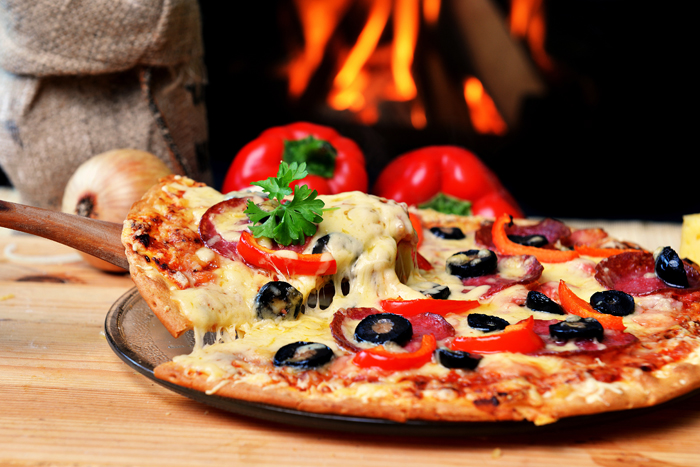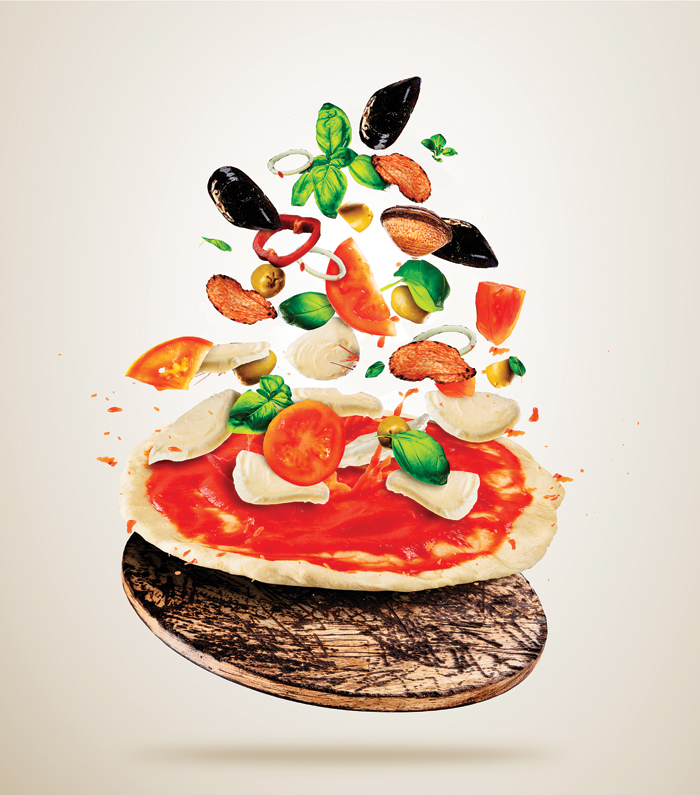Reported By: | Edited By: Sohini Das Gupta |Source: DNA |Updated: Feb 19, 2018, 06:22 PM IST
| Edited By: Sohini Das Gupta |Source: DNA |Updated: Feb 19, 2018, 06:22 PM IST
India was many decades shy of its first bite of pizza when Italian-American entertainer Dean Martin crooned, When the moon hits your eye like a big pizza pie, that’s amore… in his 1953 jazz ode to the Neapolitan flatbread. But one can argue that the wheels were set in motion. Is it surprising, that the dish that hitchhiked from the Mediterranean to post-World War II America with servicemen — rising like well-knead dough from the anonymity of immigrant neighbourhoods to flavour its own inevitable stardom — would some day land up on your table? While the trail can go gauzy in places, it’s safe to say that the evolution of the pizza, still in motion, is steeped in cultural exchanges, stretching and stringing, mozzarella-like, across continents.
Margherita, with a side of mystery
Pizza, in its modern avatar is often traced back to Raffaele Esposito, a Napoli pizzaiolo (pizza chef) whose medley of mozzarella, tomatoes and basil sprigs on flatbread, capturing the colours of the Italian flag, sought inspiration from queen Margherita during her visit in 1889. However, Italian food historian Zachary Nowak questions the theory in a BBC article titled Was Margherita pizza really named after Italy’s queen? citing discrepancies in the royal seal-bearing ‘thank you letter from the queen’ that continues to be a tourist magnet in Pizzeria Brandi, a corollary of Esposito’s establishment. Royally approved or not, the dish’s international emergence going into the mid-20th century stands undisputed, as the dogged attention of American pop culture revised this poor man’s staple into a twin symbol of comfort and aspiration.

(Thinkstock)
Pop goes the pizza
Somewhere between John Travolta’s rakish pizza strut in Saturday Night Fever and Julia Roberts’ existential exchange with the dish (Eat Pray Love), the pizza absorbed hyper-local flavours in its new continent, evolving into iconic ‘styles’ across the states of California, Chicago, New York, Detroit etc. A fixture on the early 90s telly with shows like Ninja Turtles and Friends, the empire eventually expanded eastward, flooding the Indian food space with both commercial and artisanal variations. But that's fresh history. Let us backtrack to the pizza's continent of origin, this time in Britain.
From the English Oven
British celebrity chef and restaurateur Jamie Oliver’s earliest memory of pizza-eating is seasoned with the awkwardness of adolescence. “I was 19-years-old, working and learning from (Italian chef and mentor) Gennaro Contaldo, when I tried to use a knife and fork on a pizza fresh out of the oven. Contaldo slapped my hand and said ‘No! In Italy we fold it in half!’” recalls the owner of Jamie’s Pizzeria, Mumbai. Ask him how the dish is typically enjoyed in Britain and he simply says, “People just go for different kinds, based on what they’re feeling — there’s no right or wrong way to enjoy a pizza”. Oliver’s favourite is Gennaro’s spicy sausage pizza, tossed with broccoli and “spiced salumi with amazing colour and flavour, made from the most exquisite pig used by a very small British charcuterie house we work with, and mozzarella”. Oliver, who believes the evolution to be still underway in the UK, “with cool new places popping up,” ascribes the pizza’s popularity to some simple reasons . “The pizza is easy to understand. It makes people happy. And it’s getting better and better,” points out the 42-year-old.

Pizza Americana
Baker, pizza buff and author of American Pie: My Search for the Perfect Pizza Peter Reinhart echoes Oliver’s emphasis on simplicity and adaptability when it comes to the ‘real’ pizza experience. “Pizza is just dough with something on it”, a beautiful bastard ready to flit form at every turn of land and sea, “unless you believe that only the Naples’ style of pizza is the real pizza,” reasons Reinhart, whose blog Pizza Quest documents his trail across Italy and America to deconstruct the idea of that perfect pizza. Reinhart claims that “American pizza is Italian pizza, adapted to local ingredients, fuel sources and higher protein flour, which allows for making larger pizzas that can hold more volume of toppings”, improvisations instrumental in driving the American propensity for pizza chains or franchises. Reinhart’s takeaway from the hunt was the supreme importance of the crust. “In the end I decided that the greatness of pizza was 80 per cent about the crust and 20 per cent about the toppings, whether that is the thin, medium or thick crust…pan pizzas, square pizzas or focaccia-influenced (thicker crust, baked in pans) pizzas,” he says. Places that consistently serve memorable pizza have in common one or a group of dedicated person(s), passionate about the craft, he reckons.
While it’s well-known that the New-York style of pizza influenced the large category of chain pizzerias such as Dominoes, Pizza Hut Papa John’s – agents that would later go on to inspire Indian mass mingling with the dish – Reinhart names Pizzeria Bianco in Phoenix, Arizona, as the benchmark for the perfect “Neapolitan-style pizza made with American sensibilities. Think thin, round, puffy crusts cooked in wood-fired oven, but for four minutes rather than one (as in Naples), rendering it crisp and snappy, just the way Americans like it.
Italian (Inter)national
With his Italian heritage and American celebrity, Miami-based Chef Renato Viola is the archetype of Italian-American sensibilities. Quiz the world champion in pizza acrobatics, also the brain behind Mumbai’s 1441 Pizzeria, about old-style Italian pizza, and he gushes, “Back in the day, pizza was tomato sauce, olive oil, mozzarella, basil and may be chili/garlic/pepper. That was it!”. Viola lists simple ingredients, hand-stretching and a wood-fired oven as the tricks to realising the classic taste. That, and zero tolerance for artificial additives. “The truly authentic pizza, if you were to have it in Naples, Chianti regions or at the Amalfi coast, would still be a traditional Margharita, plus-minus one topping, ” he vouches. For all the glamour of American pizza, he insists, “in European countries, when someone says pizza, everyone assumes it is the Italian type,” adding that there’s been a conscious shift towards retracing the roots of traditional pizza making since 2012.
A chaste palate does not mean the man behind Louis XIII, the world’s most expensive pizza ($12000), is averse to fresh flavours on his flatbread. If anything, he insists that his current favourite is the rather oriental-sounding ginger pizza, which explores the characters of cold Stracciatella cheese, ginger and fresh pepper, alongside a regular sauce. But there are lines the chef is sure about drawing. “I saw somewhere that they flame the pizza. That sounds crazy!” chafes Viola.

(Thinkstock)
In India, dough the desi
If you were a part of the late 80s younger generation in India, the word pizza should trigger your subconscious to scream ‘Amul cheese’. So believes chef and restaurateur Rahul Akerkar, responsible for much of Mumbai’s initial romance with ‘continental’ cuisine, including pizza. Unsullied by the pressure of thirty-minutes-nahi-toh-free, or the pretense of gourmet excess, the pizza’s early shape-shifting in India was gradual but spectacular. “There was a time when the pizza was constructed from a separate, thick, pre-baked bread dough base, which was then slathered with a thin layer of ketchup-like tomato sauce. Throw in capsicum, onions and the ubiquitous grated Amul cheese, and you had the pijjha of yore” recalls Akerkar, whose former partner venture Indigo (restaurant) can make reasonable claims to revolutionising that manner of prosaic pizza-eating. “At my first restaurant Under The Over, we were one of the early ones to make pizza the way it was meant to be made – baking the tomato sauce, toppings and cheese along with the rolled, leavened dough base together,” he says. Akerkar feels what eventually changed the pizza game for India was the availability of quality mozzarella and herbs. “Even in the 90s, I grew my own herbs from seeds bought overseas, in the garden of the house I grew up in on Altamount Road,” he reminisces.
For better or for worse, urban India has traded the generic “conti meal” for nuanced flavours at par with global standards, believes blogger-restaurateur Nikhil Merchant. For him, compiling the Indian leg of Daniel Young’s Where to Eat Pizza raked up fond memories of such “Sunday night dinners with parents”, no-frills only in hindsight. “Pasta to pizza, everything non-Indian was called continental back then", laughs Merchant. International chains and high-end, chef-driven pizzerias have succesfully seduced the Indian metropolitan market since then, but Akerkar feels that for a large section of the Indian population, the definition still holds true. Asking him where this double existence might lead the Indian pizza-cum-pijjha invites a response one cannot begin to contest: “Where does the pizza go from here?” “Into people’s mouths and bellies”. Touché.



